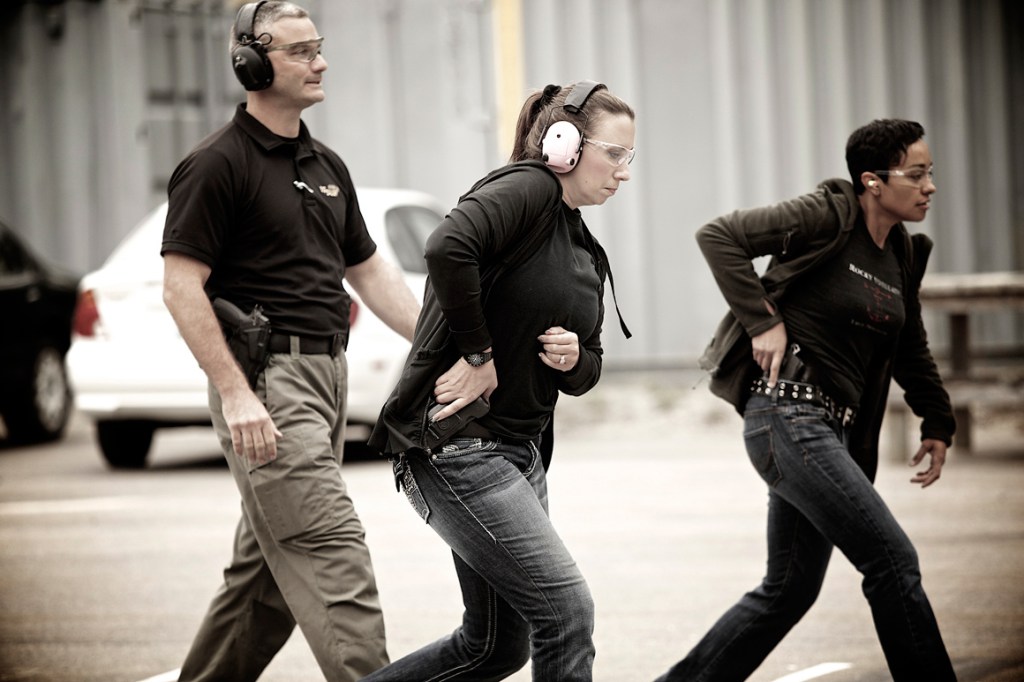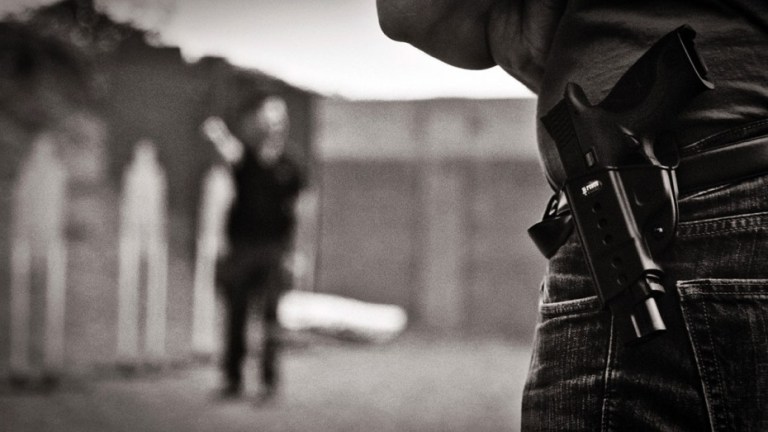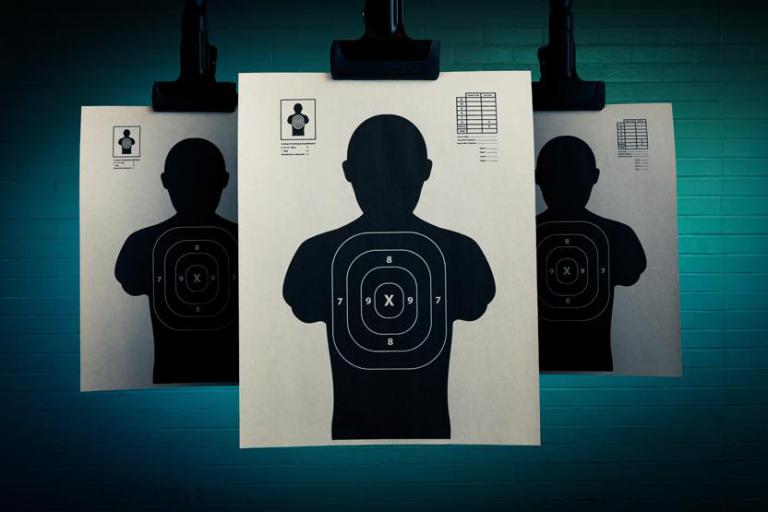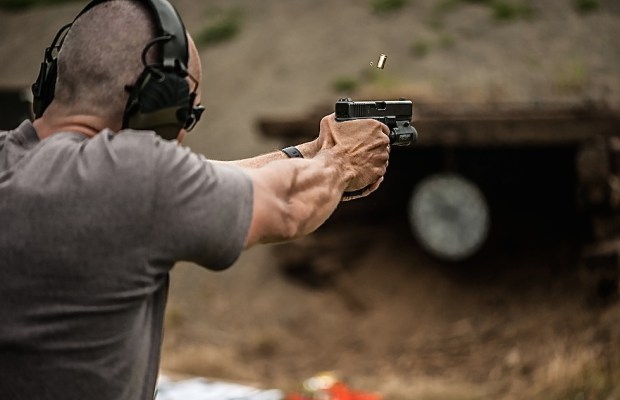Once you have selected and purchased a handgun you then need to learn how to shoot it accurately. If you have never used a handgun before, go and get some training in defensive shooting techniques. Some people, usually men, who have limited firearms experience but believe they, know everything about firearms will not undergo training. This is an ego problem and a sign of insecurity, which can end with innocent people getting hurt. Many people do not realize that the handgun techniques you see on the TV and at the movies do not work in the real world. You cannot learn how to use firearms by reading a manual or sitting down watching DVD’s or videos on YouTube, you have to go and practice. Many former and serving law enforcement and military personnel continuously seek and undergo further firearms training, because they are professional enough to know they can always learn something new and improve their skills. Firearms skills must be learned properly and then regularly practiced.
There are just as many people in the firearms training business that claim that their system is the best, just as there are self-proclaimed experts in the world of the martial arts or other fields. You can argue tactics all day and you will still get nowhere. You must find a system that works for you and learn it from an instructor who has both a good reputation and verifiable real world experience. The best systems are simple and not overly technical. If you are ever unfortunate enough to have to use your handgun in self-defense you want to be concerned about getting rounds into the bad guy, not having to thinking if you grip is correct and if your feet are in the right place.
There are many people confusing competition shooting techniques that are developed for sports and hobbies as realistic tactical training. Big difference number one, on the streets the bad guys don’t care about the rules and will be shooting back. I have had students come through my courses that have been taught and trust techniques that look cool and work in an air-conditioned shooting range with no stress but have completely no relevance in the real world. On the street, fancy techniques that overly stress safety will get you killed and hopefully only you and not those you’re possibly protecting.
You need to realistically think about how you would handle being in a hostile situation, not on a comfortable shooting range, but being attacked by criminals in some dark parking lot or your home in the early hours of the morning when there will be no one to help you. The police, if you’re lucky, maybe, there in 15 minutes if you are able to contact them; think about what the criminals can do to you and your family in those 15 minutes. Visualize this situation and determine how you would genuinely feel and determine how you would react in the seconds you may be lucky to have to reverse the situation on the criminals. There was a saying I picked up in South Africa in 94 and agree with to this day “The police are just there to pick up the bodies”. Most police like to tell you they are your protectors but the reality is, if you’re involved in a hostile situation they will not be rushing into save you, they will be thinking about their own skin. They are happy to do the after incident paperwork and to arrest you, if you live, if it means brownie points for them or, in a lot of places, an opportunity to extort money from you.

Firearms skills must be learned properly and then regularly practiced.
The Fundamentals of Defensive Shooting
The subjects that should be included in your tactical training are defensive shooting both left and right-handed, drawing from concealed carry, using different fire positions and use of cover. If you are going to work with or carry a firearm, you should undertake stress scenario training. This should include dry and live fire contact drills, in different environments, i.e. in a vehicle, in a street, in a restaurant and so forth. Proper training, handgun maintenance, carry technique/firearm access, aiming, grip/trigger pull and shot placement are the basic factors in defensive shooting.
- Training/firearms competence: You must be able to use your weapons safely and competently before you consider using it for defensive purposes. If you do not know how to use your weapon properly you are more of a danger to yourself and your love ones than the bad guys. Take the time to learn your weapon and how to use it!
- Handgun maintenance: Your handgun needs to be functional and in a good clean condition. You should have good ammunition that is in a good condition. Modern ammunition can function reliably for several years being regularly carried as long as it does not get excessively damp. But I tell my students to change their carry ammo for new rounds every six months or so, just to minimize the risks of a misfire. You need to keep your handgun clean, oiled and check it regularly. If your handgun or ammunition does not work, then everything else is a waste of time.
- Carry technique/firearm access: You need to be able to get to your handgun when you need it. You may have the cleanest $1500.00 .45 caliber handgun and be an excellent shot but this is no good if you cannot get to your handgun when you need it. I have dealt with several clients who have had handguns close to them during incidents but were unable to get to them. You must be able to get to and deploy your weapons weak and strong handed, if you can’t, again everything else is a waste of time!
- Grip: You must have a good grip on the weapon, as I have said before, having a good grip is one of the fundamentals of pistol shooting. This is where you must practice drawing your weapon and instinctively getting the right grip, the only way to you can achieve this is by repeatedly drawing and holstering your weapon; dry training. Please ensure your weapon is unloaded before you practice any dry drills.
- Aim: Once the weapon is deployed you need to stabilize and get it on target as quickly as possible. The chances are in a hostile situation you won’t be able to get into a formal shooting stance but you still need to deliver accurate fire on your target whatever position you are in. These three aiming techniques all have a place in tactical shooting.
- Slow, aimed fire. This is the most accurate and is where you apply the marksmanship principles. It involves getting a steady, properly aligned sight picture and slowly squeezing accurate shots. It is normally used for shots over 20 yards/meter or when you need precise accuracy. In tactical situations you should be behind cover or in a prone position when taking slow aimed shots, support the handgun where possible. With this technique you should be able to deliver accurate shots out to 100 + yards/meters with practice.

If you do not know how to use your weapon properly you are more of a danger to yourself and your love ones than the bad guys.
- Rapid aimed fire. For this technique you look down the top of the handgun and get a quick sight picture and shoot. This can be used against targets out to 20 yards/meters or further with practice, it’s accurate and fast. As I have previously stated whenever I use the sights I close the opposite eye to the hand the pistol is in, the same applies with this technique. Again in a tactical situation it would be best to use this technique from behind cover.
- Instinctive fire. This technique is can be used out to 10 yards/meter or more where there is no time to use the weapons sights. Forget about the sights, focuses on the target and point the handgun directly where you want the bullets to go and squeeze the trigger. This technique is simple and fast but needs practice, will talk about it more in the next chapter. At distances up to 10 yards/meters you want to be able to fire five quick shots accurately into a person, forget double tapping. At distances up to 5 yards/meters with say a 9mm handgun, most people should be able to rapid fire multiple rounds accurately into a target with a little practice using proper techniques. It all depends on them having a good grip on the weapon and a good trigger pull.
- Trigger Pull: You should practice pulling the trigger on your handgun until you can do so smoothly. One trick (make sure your handgun is unloaded) is to balance an empty bullet case on the top of your handgun, near the front sight and practice dry firing, the aim is you to keep the case there for as many trigger pulls as possible. If that is too easy try a coin balanced on your front sight. You want to fire a minimum of five quick shots into a person when in hostile situations at close quarters. You should keep putting rounds into the criminal or terrorist until they no longer pose a threat.
- Shot Placement: In a hostile shooting incident, the criminal or terrorist must be incapacitated immediately, a wounded the criminal or terrorist can still be very dangerous. Shot placement is everything and takes priority over caliber. A shot to the brain with a .22 will drop someone where as a .45 hollow point to the stomach may kill someone in the long run but short-term the bad guy you just shot can still fight and shoot you. You need to train as you intend to fight, that’s old knowledge but it makes me laugh on most gun ranges to see people, civilians and law enforcement shooting center of mass on silhouette targets. What vital organs or bones are at your center of mass? None! The only reason I see for people being told to shoot center of mass is so they can pass qualifications with minimum effort and training. You need to be training to hit vital organs or bones, if not then you are going to be surprised when the bad guy you have just shot keeps shooting back at you.

You need to be training to hit vital organs or bones, if not then you are going to be surprised when the bad guy you have just shot keeps shooting back at you.
- The best shot placement that guarantees nearly 100% immediate incapacitation of the target is to the brain. Shots should be below the middle of the forehead, and above the upper lip or to the side of the head above the center of ear from the cheekbones back. I have heard many people say the head is too small of a target area; well it is if you’re trying to get poorly trained personnel to pass security or law enforcement shooting qualifications. But for people who want to take the time and train properly head shots can be achieved instinctively at close quarters in a short period of time. One thing that annoys me with society in general is that these days all standards are being set to the lowest level, just because one person is incompetent it does not mean everyone is, but we can’t hurt the feelings of the incompetent ones can we… I live in a different world and understand that as far as violent situations are concerned you need to be at the highest standard and end the situation as quickly as possible. Five rapid rounds from a trained shooter towards the head of a bad guy at conversational range will end the conversation very quickly. Also, these days with body armor being freely available and the fact the criminals or terrorists may be on narcotics head-shots should be your first target area of choice.
- The center of the upper chest, just below the neck is also a good target area. Shots that hit the lungs can be fatal but may take time to drop a target, shots the heart will kill a target instantly. I tell my students that aiming just below the neck ensures that if their shots are low or high they are still hitting vital areas on the target. Another reason for mixing my ammunition between HP’s and FMJ rounds is because I want penetration; if a bullet hits a target’s spine they are instantly paralyzed. As I’ve said shots to the lungs can be fatal but can take time to drop a target. During this time, the criminal or terrorist can still return effective fire, this is again why I tell people fire a minimum of five rounds and you need to be aggressive. If a criminal is returning fire the chances are their arms and weapon will be in front of their chest, so we need the multiple shots and ammunition that will penetrate to ensure hits on the vital areas. This area of the body may also be covered by heavy clothing, objects such as cell phones that may deflect or prevent a bullets penetration. Also, if the criminal is wearing a bullet-proof vest this can prevent rounds hitting the vital areas, be aggressive and keep shooting until the target is down. If shooting at moving targets or targets at distances over 10 yards/meters or if you know you cannot get the head shot, you should shoot for upper chest.
- Shots to the stomach or lower can kill someone but are rarely effective in dropping a target immediately, this is again where I would say FMJ ammo could be effective for penetrating to the spine or breaking the pelvis.
Remember!
- Speed and accuracy are your main concern. Get your weapon out and get multiple and accurate rounds into the target as quickly as possible
- Always fully load your weapon; magazine to be fully loaded and put a round in the chamber where legal to do so. I am currently writing this in Nigeria and in one incident here recently, three police officers were killed in what we believe to be an attempted hit on someone they were escorting. They approached a car that was blocking the road and their client’s vehicle, as they got close a criminal opened up on them with an AK-47, all 3 died at the scene. They were carrying AK’s also but with the safety catches on and no rounds in the chambers, they did not stand a chance.
- Always know what is beyond your target. A dead bystander means manslaughter if not murder charge. Go for headshots at close quarters; otherwise go for the upper chest area/base of the neck.
- In the US, the majority of police officers killed in shooting incidents are shot at conversational range, at distances of up to 10 feet. Over 50% are shot at distances under 5 feet. At these distances there is no need to use the weapons sights, be aggressive point and shoot!
- Two out of every three police officers killed in the US are shot at night or in low-light areas. If you can point shoot these is no need to worry about night sights and lasers etc. as you are not using the sights anyway. We will talk later about the use of flashlights/torches.
- The most common handgun calibers used against American police officers are 9-millimeter and .38. These two calibers accounted for 50 percent of the handgun deaths. In most places in the world you will find 9mm and .38 caliber weapons, they have been around for nearly 100 years and I expect will be around for a long time to come.
- Shooting incidents are over in seconds, you will not have time to chamber a round, get into a range stance, check breathing and use the sights on your weapon. You should keep a round in the chamber, have access to the handgun, be aggressive and get rounds into the targets vital areas of the target as quickly as possible.
- Criminals or terrorists usually operate in gangs so, in time train for engaging multiple targets.
- Terrorists and criminals like guns, they train in police and military techniques using manuals and videos that are freely available on the commercial market. It’s up to you to train harder and be at a more professional level than they are.
- Always be aware of your environment, you want spot any potential problems and avoid them or at least be ready. If it gets to the point where the criminal has set you up and has a weapon on you, you’re going to have problems. Best to always try to avoid the problems and confrontations!






